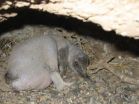(Press-News.org) CORVALLIS, Ore. – One of the first studies of its type has confirmed that a science museum can strongly influence the public's knowledge and attitudes about science and technology, and to a surprising degree can cut across racial, ethnic, educational and economic barriers.
The study focused on the California Science Center in Los Angeles, and offers profound support for the value of such institutions. It also reinforces the emerging concept of "free choice" learning, which holds that people get most of their knowledge about science from someplace other than school or formal education.
The comprehensive, multi-year analysis was one of the first of its kind ever done, researchers said, based on extensive surveys of thousands of adults in the past decade by scientists from Oregon State University. The findings were recently published in the Journal of Research in Science Teaching.
"The holy grail of science museums is not to provide someone all the knowledge they need, but to inspire them, to become a launching point," said John Falk, an OSU professor of science education and national leader in the free-choice learning movement. "Many people have believed that such institutions could do this, but this study provides some of the first definitive evidence that it works.
"Overall, these results were staggering, much more positive than I could have imagined," he said.
According to the survey findings:
More than half of the residents in Los Angeles County, over one million a year, have visited the Science Center since it opened in 1998, and say it strongly improved their understanding of science issues.
Residents who visited the Science Center were among the most knowledgeable Los Angeles residents about science and technology, and their visit significantly contributed to this.
The makeup of visitors was broadly representative of the general population, including all races, ethnicities, ages, education and income levels.
More than a quarter of visitors were Hispanic, and some of the strongest beliefs about positive impacts were expressed by minority and low-income individuals.
While other leisure activities were decreasing in the past decade, adult use of the Internet, watching educational programs on television, and listening to educational programs in other formats increased.
Nearly all adults who said their children had visited the Science Center reported an increase in their children's knowledge of science and technology, and large majorities said the visit raised their long-term interest level.
The attraction to the museum was amazingly broad – no one zip code accounted for more than 2 percent of the visitation.
"There is a growing appreciation that Americans learn most of what they know about science outside of school," Falk said. "Institutions like science museums can play an important part in that."
According to Mark Needham, an assistant professor in the OSU Department of Forest Ecosystems and Society and co-author on the study, these surveys were unlike almost all done previously. They did not just sample visitors to a museum or science center, but sought out and interviewed a representative cross-section of the general public, he said.
The institution that is now the California Science Center has a long history, tracing its roots to the State Exposition Building constructed about a century ago. It underwent a total reconstruction that was completed in 1998, and three major surveys were conducted since that time – one in 1997, one in 2000 and the results of this study from a survey in 2009. The work has been supported by the Noyce Foundation of California, and some earlier studies by the National Science Foundation and James Irvine Foundation.
The Science Center itself is a remarkable, 245,000-square-foot facility with many outstanding exhibits, and it's free. But other cities have similar facilities and attendance despite charging fees, Falk noted. And it seems to be working.
"Can you define homeostasis?" Falk asked. "Most people can't. But in Los Angeles, nearly half of the public say they've heard of the term, and 20 percent of them can now give you a decent definition. There was an exhibit on homeostasis at the museum after it re-opened, where a 50-foot-tall animatronic woman named Tess explained it."
Researchers used this exhibit and the concept of homeostatis as a "marker" to demonstrate that what was presented at the Science Center was actually learned. And lest you feel out-of-touch or uninformed, homeostasis is the balance that organisms or cells try to maintain.
Anyway, that's what Tess says. And apparently in Los Angeles, when Tess talks, people listen.
"It has long been assumed that formal schooling is the primary mechanism by which the public learns science," the researchers wrote in their study. "But in recent years there has been a growing appreciation for the fundamental role played by the vast array of non-school science education institutions."
"Large numbers of the general public have benefited," they said.
###
Editor's Note: Digital images are available to illustrate this story. If you use one of them, please give photo credit to the California Science Center. They can be downloaded at these URLs:
Tess exhibit: https://picasaweb.google.com/CaliforniaScienceCenter/Tess?authkey=Gv1sRgCL-2xdearL7zEA#
Student learning exhibit: https://picasaweb.google.com/CaliforniaScienceCenter/KidsAtTheCaliforniaScienceCenter?authkey=Gv1sRgCLzwv9XtxsjAJg#5593003567752060562
Contact: John Falk, 541-737-1826 or falkj@science.oregonstate.edu; Mark Needham, 541-737-1498 or mark.needham@oregonstate.edu
END
Neurosurgeons from NYU Langone Medical Center will present techniques and discuss surgical approaches and applications of technology at the annual meeting of the American Association of Neurological Surgeons (AANS), held April 9-13, 2011 at the Colorado Convention Center in Denver.
The Department of Neurosurgery at NYU Langone Medical Center has been recognized as one of the top ten hospitals in the country for neurology and neurosurgery by U.S. News & World Report for the past three years. This year, the department expanded its expertise with the addition of several ...
Researchers from the Wildlife Conservation Society, the University of Washington, and other groups are grappling with a wildlife mystery: Why are some penguin chicks losing their feathers?
The appearance of "naked" penguins—afflicted with what is known as feather-loss disorder—in penguin colonies on both sides of the South Atlantic in recent years has scientists puzzled as to what could be causing the condition.
A study on the disorder appears in a recent edition of the journal Waterbirds. The authors of the paper are: Olivia J. Kane, Jeffrey R. Smith, and P. Dee ...
OAK RIDGE, Tenn, April 8, 2011 -- A newly sequenced bacterial genome from a team led by the Department of Energy's Oak Ridge National Laboratory could contain clues as to how microorganisms produce a highly toxic form of mercury.
Methylmercury, a potent human neurotoxin, appears in the environment when certain naturally occurring bacteria transform inorganic mercury into its more toxic cousin. Few bacterial species are capable of this conversion, and exactly how the transformation takes place has been a matter of debate for decades.
"What is not known are the genes ...
The hand moves the computer mouse, but the cursor doesn't comply. The cursor doesn't go where told.
The hand tries again. The cursor shoots past the intended target.
The hand tries a third time – and the cursor loops farther from the target than where it started. And the user is frustrated.
So it often goes for computer users whose motor disabilities prevent them from easily using a mouse.
As the population ages, more people are having trouble with motor control, but a University of Washington team has invented two mouse cursors that make clicking targets a whole ...
WASHINGTON, D.C. – It is important that the United States begin to live within its means and address the federal deficit. But APS believes that as a nation we need to be smart about how we do it. Cutting spending across the board without a clear understanding of what it means for America's future jeopardizes the very future we want to secure for our children.
For more than half a century, science and technology have been the primary drivers of job creation and economic growth. Slashing spending on science, as the budget plans of the House of Representatives call for, ...
The phrase "invasive plant species" typically evokes negative images such as broad swaths of kudzu smothered trees along the highway or purple loosestrife taking over wetlands and clogging waterways—and as such, invasive plants are largely viewed as major threats to native biodiversity. However, research has shown both that invasive species may be one of the most important threats to biodiversity and that plant invasions are rarely the cause for native species extinctions. How can these conflicting pieces of evidence be reconciled?
Kristin Powell, from Washington University, ...
SAN DIEGO, April 8, 2011 -- A reformed Medicaid program must put coordinated primary care at the forefront of its efforts, the American College of Physicians (ACP) said in a new position paper released today at Internal Medicine 2011, ACP's annual scientific meeting. Medicaid and Health Care Reform highlights how primary care physicians will assume a major role in providing care to Medicaid beneficiaries.
"The Medicaid program faces significant changes in the next few years as millions of current and newly eligible people will receive Medicaid coverage," said J. Fred ...
A study by Indiana University sociologists found that many Americans had inflated views of minority students' opportunities to attend college, yet a large contingent - around 43 percent of people surveyed - believed that low income students had fewer opportunities for college access.
The study, which will be discussed on Monday at the American Educational Research Association's meeting in New Orleans, found that Americans have varying beliefs when it comes to college access. A quarter of the people interviewed thought minority and low-income students held a better position ...
A preliminary study conducted by a team at the National Institutes of Health has identified a promising new treatment in children for the most common form of a rare disorder. The syndrome is called periodic fever associated with aphthous stomatitis, pharyngitis and cervical adenitis — or PFAPA — and is characterized by monthly flare-ups of fever, accompanied by sore throat, swollen glands and mouth lesions.
The proposed treatment, which will be validated in a larger study before it is recommended in treating PFAPA syndrome, wards off an inappropriate immune system attack ...
VANCOUVER, BC, April 09, 2011 /24-7PressRelease/ -- This is the first of a six-part series on improving your writing style. Whether you write for business or academic purposes, there are a few golden rules that will help you sharpen up your prose.
Part 1: Avoid wordiness and repetition
Many of us fall into this trap, for various reasons. Possibly this is just a bad habit we have got into or perhaps we feel that we need to have extra words, either to reinforce our point, or (Heaven forbid) to 'pad out' our academic writing to make up a stipulated word count. If you ...


